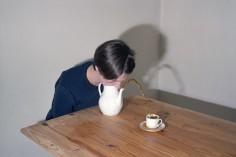THOMAS MAILAENDER
source: madagencyfr
Thomas Mailaender, véritable passionné d’image vernaculaire et collectionneur de l’étrange se concentre sur la source des sujets qu’il s’approprie via des images glanées sur internet, dans les vide-greniers et les brocantes. Sa facilité à combiner des images de l’ère du numérique avec des procédés anciens comme le cyanotype ou la céramique, qui tiennent une place particulière dans l’histoire de l’art témoigne de sa capacité à d’agréger l’absurde en un ensemble construit et lui faire atteindre le statut d’oeuvre d’art.
Résident de la SIRA où il à son atelier depuis 2012, Thomas à notamment collaboré avec Paul Armand-Delille sur les pochettes d’album de Roudani 434 et American Dream. MAD à organisé en Juin 2014 son exposition Cyanotypes et il exposera XXSTUDIOXX aux côtés d’Anatole Maggiar lors de Paris Photo.
.
.
.
.
.
.
.
source: thomasmailaender
A recently deceased famous French critic once compared Thomas Mailender’s work to that of Bernd and Hilla Becher under the influence of Pastis, a local aniseed liquor popular in the south of France.
«Sorry, but you cannot bring your own artwork at the fair,» said a security guard when he discovered Thomas Mailaender’s improvised and unauthorized performance, a remote-controlled wheeled reproduction of the Centre Pompidou building, entitled Centre Pompidou is closed for holiday, 2010, moving along an aisle of the Armory Show in New York. The guard at the fair couldn’t know his offhand remark described exactly what Mailaender was doing; he constantly hijacks art milieu conventions and sidesteps expectations by pirate exhibiting persona-non-grata items and manners. He focuses on the source material and subjects and appropriates and diverts found images from the Internet, flea markets and the like. Mailaender is an insatiable and compulsive collector of photographs and sociological patterns. One of his major investigations is a typological survey, inventory and recycling of human behavior, particularly hobbies and incidental activities, using entertainment as a substance and a means to develop his practice. Through his mise en abyme of the frivolous he allows a multitude of amateur and/or vernacular objects, images and customs to attain the status of artworks, repeatedly questioning the notion of artistic legitimacy.
Caroline Niémant, Peeping Tom.
.
.
.
.
.
.
.
source: thomasmailaender
« Mailaender’s forum and sphere of operations is less the art world than the rowdier public domain where events can easily run out of control. Society evolved a livid counter-culture, staffed by fallen angels of all sorts. When exactly that culture originated is unclear, but it flourishes and services a fevered public imagination entranced by its own wit and jokes. The majority of solid citizens follow football, for instance, for the artistry of the game, but a hard core of activists revel in its shouted and insulting poetry. If art is to put itself on a par with such a spontaneous and convulsive counter-culture it has to cultivate the kind of suddenness which is Mailaender’s forte. »
Ian Jeffrey.
.
.
.
.
.
.
.
source: itsnicethat
French multimedia artist, Thomas Mailaender creates work that is fun and funny. He orchestrates strangeness and documents it in what he describes as “insignificant, incidentally grotesque moments that possess an abrupt and unexpected monumentality.” Like Cathedral Cars, the beyond ridiculous, sculpturally over-laden vehicles, portraits with really big things (pictured, Items) and a performance piece in which he deposited an “ultrarealistic” and massive mussel shell on a beach then notified the local papers. Nice-Matin lead with: “A polyester monster: one mussel that will be hard to swallow.”
.
.
.
.
.
.
.
source: getxophoto
Se trata, indiscutiblemente, de un chico malo que sólo hace tonterías, sobretodo con las imágenes, pero no sólo con ellas. No respeta nada, comenzando por la fotografía, esencialmente cuando se la considera respetable en nombre de un cierto buen gusto que remite a convenciones sociales y estéticas que perfuman el salón –o El Salón de las Artes, si se prefiere– y lo Bello con mayúsculas. De hecho, se interesa por el uso social de la imagen a pesar de que, fingiendo tomarse todo desenfadadamente, le infringe un cierto maltrato y disimula sus análisis tras sus bromas de estudiante. Nos engaña con su juego así como nosotros nos dejamos engañar por unas imágenes que quisiéramos que fueran “auténticas”, “bellas”, “remarcables” o “justas”. Persigue su deconstrucción cuestionando la “vulgaridad” que practica con un rotundo sentido de lo que no debe hacerse, lo que provoca a su vez grandes carcajadas o una rabia inmensa. Además, como el mundo está mal hecho, este muchacho tiene mucha suerte y ha recibido muchos cheques… ¡en dólares! Lo demuestra mediante una serie de autorretratos que atestiguan que se trata de algo verdaderamente cierto.
Nacido en Marsella en 1979. En 2003 terminó sus estudios en la École nationale supérieure des Arts Décoratifs de París y continuó estudiando durante un año más en Villa Arson en Niza. Desde entonces su trabajo se ha centrado en jugar con el concepto ya clásico de la tipología. Un crítico francés recientemente fallecido comparó su obra con la de Bern y Hilla Becher bajo la influencia del Pastis, un licor anisado popular en el sur de Francia. Ha expuesto en varias ciudades de todo el mundo.


